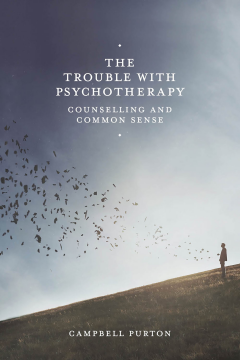
Additional Information
Book Details
Abstract
Current therapeutic practice is grounded in traditional theories of psychotherapy, such as the theories that underlie cognitive-behavioural, psychodynamic and person-centred practice. But none of these approaches has been proven to be more effective than any other, leaving the therapist with an ethical and professional dilemma: how do you advocate and practise one theory with your clients, when a completely different theoretical approach is being successfully practised down the road?
In this book Campbell Purton argues that psychotherapy and counselling theories fail to provide adequate justification for their practice. Part 1 highlights the weaknesses and dangers that underlie traditional counselling theories and their derivatives, including psychodynamic, cognitive behavioural, existential and neuroscience approaches. Having unpicked these theories, Part 2 goes on to develop an exciting new way of thinking about therapy that does not rely on theory - one that can be likened to a 'common sense' approach to therapeutic practice.
This book poses important questions and offers unique insight for anyone studying or practising in the field of counselling and psychotherapy.
Campbell Purton has managed to explain, where others have failed, how it is that psychotherapy of many theoretical varieties can and actually does work. He develops an adequate understanding of psychotherapy, a last: an understanding that is not itself a theory.' - Dr. Rupert Read, Reader in Philosophy, School of Philosophy, Politics and Languages.
Campbell Purton is Associate Tutor at the Centre for Counselling Studies, University of East Anglia. He is the author of Person-Centred Therapy: The Focusing-Oriented Approach (2004, Palgrave) and The Focusing-Oriented Primer (2007, PCCS Books).
Table of Contents
| Section Title | Page | Action | Price |
|---|---|---|---|
| Cover | Cove | ||
| Contents | vii | ||
| Acknowledgements | x | ||
| Introduction | 1 | ||
| The origins of the book | 5 | ||
| PART I: THE TROUBLE | 11 | ||
| 1 The Effectiveness of Psychotherapy | 13 | ||
| The place of theory in psychotherapy | 17 | ||
| A postmodern alternative | 21 | ||
| The identity and commitment issue | 26 | ||
| Summary | 27 | ||
| 2 Theories and Common Sense | 30 | ||
| Theories, regularities and explanatory pictures | 30 | ||
| Reasons for rejecting a theory | 33 | ||
| Incoherent theories and misleading pictures | 35 | ||
| Common sense and everyday language | 41 | ||
| Summary | 45 | ||
| 3 Historical Prologue: Behaviourism and Behaviour Therapy | 46 | ||
| Introduction | 46 | ||
| The common-sense core of behavioural therapy | 47 | ||
| The theory and its confusions | 50 | ||
| The theory and its dangers | 57 | ||
| Summary | 58 | ||
| 4 Person-Centred Therapy | 59 | ||
| The common-sense core | 59 | ||
| Variants of the person-centred approach | 63 | ||
| The ‘core conditions’ and common sense | 64 | ||
| Self-deception | 65 | ||
| The theory and its confusions | 67 | ||
| The theory and its dangers | 77 | ||
| Summary | 80 | ||
| 5 Psychodynamic Therapy | 81 | ||
| The common-sense core | 81 | ||
| The theory and its confusions | 85 | ||
| The theory and its dangers | 93 | ||
| Summary | 98 | ||
| 6 Cognitive-Behavioural Therapy | 99 | ||
| The cognitive procedures of CBT | 99 | ||
| The common-sense core | 101 | ||
| Cognitive theory and its confusions | 103 | ||
| The theory and its dangers | 114 | ||
| Summary | 117 | ||
| 7 Process-Experiential/Emotion-Focused Therapy | 118 | ||
| The common-sense core: ‘treatment tasks’ in PET | 120 | ||
| The theory and its confusions | 123 | ||
| Dialectical constructivism | 126 | ||
| Summary | 129 | ||
| 8 Existential Therapy | 131 | ||
| Three principles of existential therapy | 132 | ||
| The practice of existential therapy | 135 | ||
| The existential approach and its dangers | 136 | ||
| Summary | 139 | ||
| 9 Neuroscience | 140 | ||
| Relating the person to their brain | 142 | ||
| Summary | 148 | ||
| PART II: STARTING AGAIN | 149 | ||
| 10 The Troubled Client | 151 | ||
| Psychiatric classification: The DSM | 153 | ||
| A common-sense classification | 156 | ||
| Type A troubles | 158 | ||
| Type B troubles | 158 | ||
| Type C troubles | 159 | ||
| Therapy, psychiatry and medication | 162 | ||
| Summary | 164 | ||
| 11 Psychotherapy Integration | 166 | ||
| A common-sense account of what therapists do | 166 | ||
| Three therapeutic accounts | 171 | ||
| Integrating the accounts | 172 | ||
| Attachment patterns | 176 | ||
| ‘Balancing’ and the ‘zigzags’ | 177 | ||
| A traditional background for the common-sense rationale | 180 | ||
| Summary | 183 | ||
| 12 Implications for Practice and Training | 187 | ||
| Summary of the suggested principles of therapy | 187 | ||
| Implications for practice | 188 | ||
| Implications for training | 193 | ||
| Summary and conclusion | 198 | ||
| References | 200 | ||
| Index | 210 |
